FIAT DOBLO COMBI 2013 Owner handbook (in English)
Manufacturer: FIAT, Model Year: 2013, Model line: DOBLO COMBI, Model: FIAT DOBLO COMBI 2013Pages: 283, PDF Size: 6.31 MB
Page 131 of 283
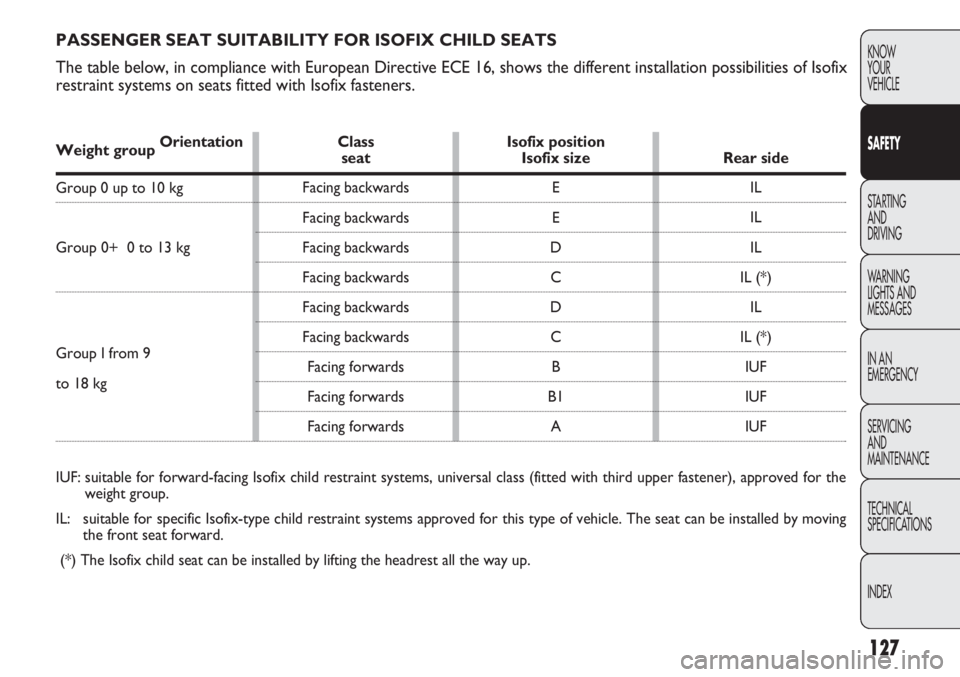
127
KNOW
YOUR
VEHICLE
SAFETY
STARTING
AND
DRIVING
WARNING
LIGHTS AND
MESSAGES
IN AN
EMERGENCY
SERVICING
AND
MAINTENANCE
TECHNICAL
SPECIFICA
TIONS
INDEX
PASSENGER SEAT SUITABILITY FOR ISOFIX CHILD SEATS
The table below, in compliance with European Directive ECE 16, shows the\
different installation possibilities of Isofix
restraint systems on seats fitted with Isofix fasteners.
E
E
D C
D C B
B1 A IL
IL
IL
IL (*) IL
IL (*) IUF
IUF
IUF
Weight group
Orientation Class Isofix position
seat
Isofix size Rear side
Group 0 up to 10 kg
Group 0+ 0 to 13 kg
Group I from 9
to 18 kg
IUF: suitable for forward-facing Isofix child restraint systems, universal cl\
ass (fitted with third upper fastener), approved f or the
weight group.
IL: suitable for specific Isofix-type child restraint systems approved for t\
his type of vehicle. The seat can be installed by moving
the front seat forward.
(*) The Isofix child seat can be installed by lifting the headrest all\
the way up. Facing backwards
Facing backwards
Facing backwards
Facing backwards
Facing backwards
Facing backwards
Facing forwards
Facing forwards
Facing forwards
Page 132 of 283
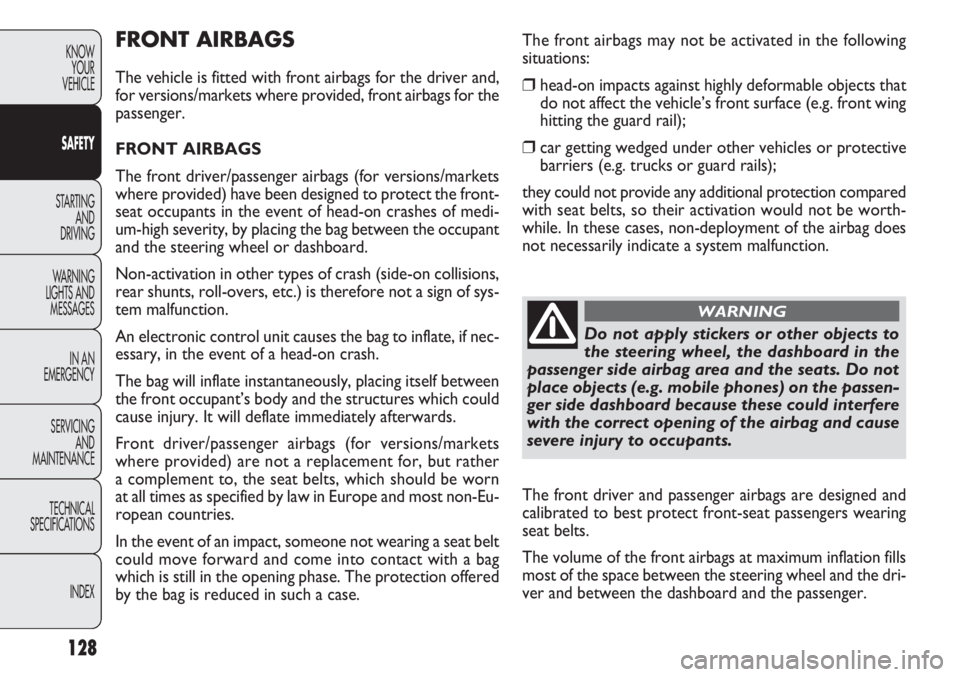
128
KNOWYOUR
VEHICLE
SAFETY
STARTING AND
DRIVING
W ARNING
LIGHTS AND MESSAGES
IN AN
EMERGENCY
SERVICING AND
MAINTENANCE
TECHNICAL
SPECIFICA
TIONSINDEX
FRONT AIRBAGS
The vehicle is fitted with front airbags for the driver and,
for versions/markets where provided, front airbags for the
passenger.
FRONT AIRBAGS
The front driver/passenger airbags (for versions/markets
where provided) have been designed to protect the front-
seat occupants in the event of head-on crashes of medi-
um-high severity, by placing the bag between the occupant
and the steering wheel or dashboard.
Non-activation in other types of crash (side-on collisions,
rear shunts, roll-overs, etc.) is therefore not a sign of sys-
tem malfunction.
An electronic control unit causes the bag to inflate, if nec-
essary, in the event of a head-on crash.
The bag will inflate instantaneously, placing itself between
the front occupant’s body and the structures which could
cause injury. It will deflate immediately afterwards.
Front driver/passenger airbags (for versions/markets
where provided) are not a replacement for, but rather
a complement to, the seat belts, which should be worn
at all times as specified by law in Europe and most non-Eu-
ropean countries.
In the event of an impact, someone not wearing a seat belt
could move forward and come into contact with a bag
which is still in the opening phase. The protection offered
by the bag is reduced in such a case. The front airbags may not be activated in the following
situations:❒head-on impacts against highly deformable objects that
do not affect the vehicle’s front surface (e.g. front wing
hitting the guard rail);
❒car getting wedged under other vehicles or protective
barriers (e.g. trucks or guard rails);
they could not provide any additional protection compared
with seat belts, so their activation would not be worth-
while. In these cases, non-deployment of the airbag does
not necessarily indicate a system malfunction.
Do not apply stickers or other objects to
the steering wheel, the dashboard in the
passenger side airbag area and the seats. Do not
place objects (e.g. mobile phones) on the passen-
ger side dashboard because these could interfere
with the correct opening of the airbag and cause
severe injury to occupants.
WARNING
The front driver and passenger airbags are designed and
calibrated to best protect front-seat passengers wearing
seat belts.
The volume of the front airbags at maximum inflation fills
most of the space between the steering wheel and the dri-
ver and between the dashboard and the passenger.
Page 133 of 283
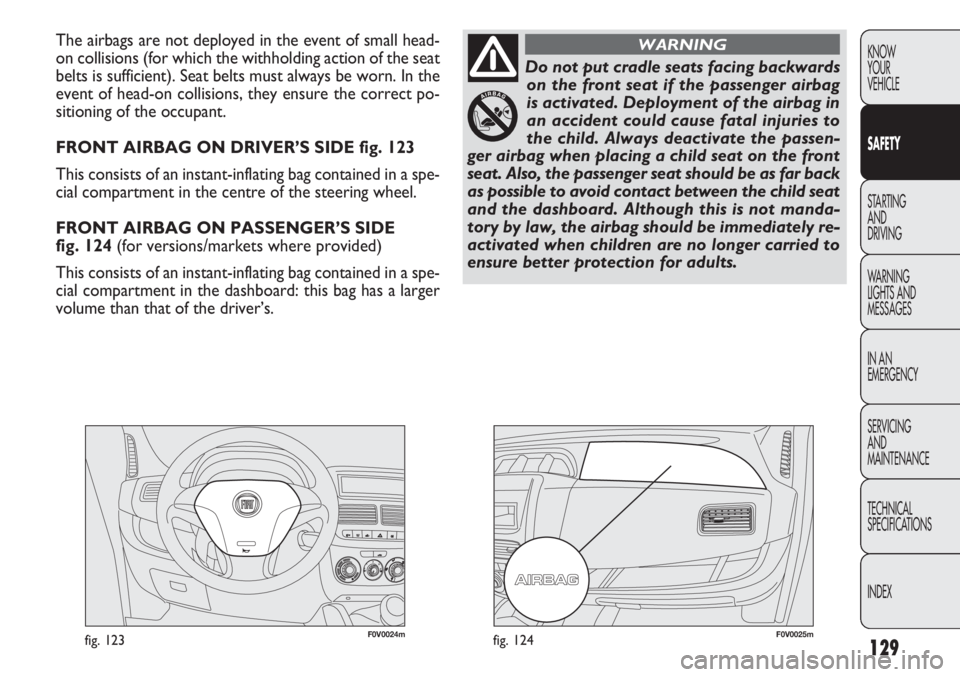
129
KNOW
YOUR
VEHICLE
SAFETY
STARTING
AND
DRIVING
WARNING
LIGHTS AND
MESSAGES
IN AN
EMERGENCY
SERVICING
AND
MAINTENANCE
TECHNICAL
SPECIFICATIONS
INDEX
F0V0024mfig. 123F0V0025mfig. 124
The airbags are not deployed in the event of small head-
on collisions (for which the withholding action of the seat
belts is sufficient). Seat belts must always be worn. In the
event of head-on collisions, they ensure the correct po-
sitioning of the occupant.
FRONT AIRBAG ON DRIVER’S SIDE fig. 123
This consists of an instant-inflating bag contained in a spe-
cial compartment in the centre of the steering wheel.
FRONT AIRBAG ON PASSENGER’S SIDE
fig. 124 (for versions/markets where provided)
This consists of an instant-inflating bag contained in a spe-
cial compartment in the dashboard: this bag has a larger
volume than that of the driver’s.
Do not put cradle seats facing backwardson the front seat if the passenger airbag
is activated. Deployment of the airbag in
an accident could cause fatal injuries to
the child. Always deactivate the passen-
ger airbag when placing a child seat on the front
seat. Also, the passenger seat should be as far back
as possible to avoid contact between the child seat
and the dashboard. Although this is not manda-
tory by law, the airbag should be immediately re-
activated when children are no longer carried to
ensure better protection for adults.
WARNING
Page 134 of 283
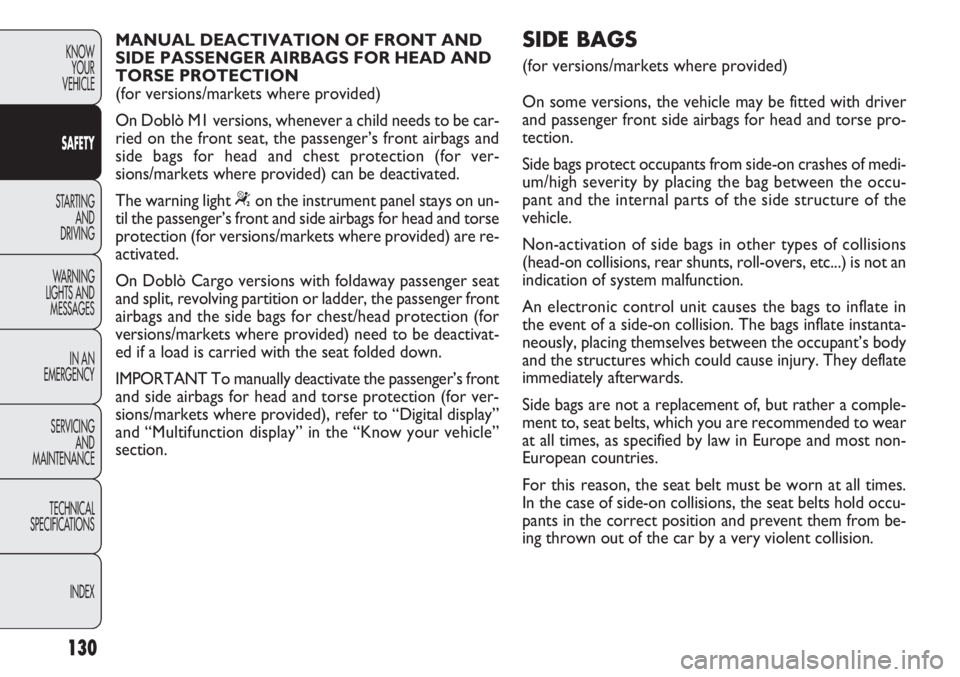
130
KNOWYOUR
VEHICLE
SAFETY
STARTING AND
DRIVING
W ARNING
LIGHTS AND MESSAGES
IN AN
EMERGENCY
SERVICING AND
MAINTENANCE
TECHNICAL
SPECIFICA
TIONSINDEX
MANUAL DEACTIVATION OF FRONT AND
SIDE PASSENGER AIRBAGS FOR HEAD AND
TORSE PROTECTION
(for versions/markets where provided)
On Doblò M1 versions, whenever a child needs to be car-
ried on the front seat, the passenger’s front airbags and
side bags for head and chest protection (for ver-
sions/markets where provided) can be deactivated.
The warning light
“on the instrument panel stays on un-
til the passenger’s front and side airbags for head and torse
protection (for versions/markets where provided) are re-
activated.
On Doblò Cargo versions with foldaway passenger seat
and split, revolving partition or ladder, the passenger front
airbags and the side bags for chest/head protection (for
versions/markets where provided) need to be deactivat-
ed if a load is carried with the seat folded down.
IMPORTANT To manually deactivate the passenger’s front
and side airbags for head and torse protection (for ver-
sions/markets where provided), refer to “Digital display”
and “Multifunction display” in the “Know your vehicle”
section.
SIDE BAGS
(for versions/markets where provided)
On some versions, the vehicle may be fitted with driver
and passenger front side airbags for head and torse pro-
tection.
Side bags protect occupants from side-on crashes of medi-
um/high severity by placing the bag between the occu-
pant and the internal parts of the side structure of the
vehicle.
Non-activation of side bags in other types of collisions
(head-on collisions, rear shunts, roll-overs, etc...) is not an
indication of system malfunction.
An electronic control unit causes the bags to inflate in
the event of a side-on collision. The bags inflate instanta-
neously, placing themselves between the occupant’s body
and the structures which could cause injury. They deflate
immediately afterwards.
Side bags are not a replacement of, but rather a comple-
ment to, seat belts, which you are recommended to wear
at all times, as specified by law in Europe and most non-
European countries.
For this reason, the seat belt must be worn at all times.
In the case of side-on collisions, the seat belts hold occu-
pants in the correct position and prevent them from be-
ing thrown out of the car by a very violent collision.
Page 135 of 283

131
KNOW
YOUR
VEHICLE
SAFETY
STARTING
AND
DRIVING
WARNING
LIGHTS AND
MESSAGES
IN AN
EMERGENCY
SERVICING
AND
MAINTENANCE
TECHNICAL
SPECIFICA
TIONS
INDEX
IMPORTANT The best protection in the event of side-on
crash is achieved by maintaining a correct position on the
seat. This allows the side bag to be correctly deployed.
IMPORTANT Do not wash the seats with water or pres-
surised steam (by hand or at automatic seat washing sta-
tions).
GENERAL WARNINGS
The front airbags and/or side bags (where provided) may
be deployed if the vehicle is subject to heavy knocks or ac-
cidents involving the underbody area, such as for exam-
ple violent shocks against steps, kerbs or low obstacles, or
the vehicle falling into big potholes or depressions in the
road.
A small amount of dust will be released when the airbags
are deployed. The dust is not harmful and does not indi-
cate the beginning of a fire. Furthermore, the surface of
the deployed bag and the interior of the vehicle may be
covered in a dusty residue: this may irritate your skin and
eyes. Wash with mild soap and water in the event of ex-
posure.
Should an accident occur in which any of the safety devices
are activated, take the vehicle to a Fiat Dealership to have
the activated devices replaced and to have the whole sys-
tem checked.
Any airbag checks, repairs or replacements must be car-
ried out at a Fiat Dealership.
SIDE BAGS fig. 125
(for versions/markets where provided)
They consist of an instant-inflating bag housed in the front-
seat backrest and have the job of protecting the occupant’s
torso and head in the event of a side-on collision of medi-
um/high severity.
F0V0026mfig. 125
Page 136 of 283
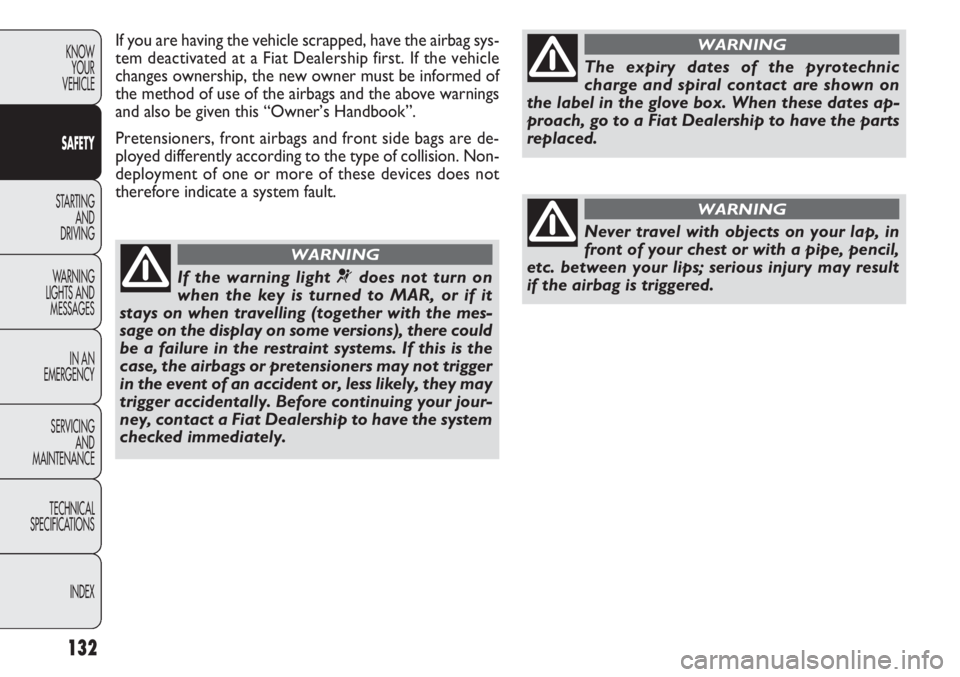
132
KNOWYOUR
VEHICLE
SAFETY
STARTING AND
DRIVING
W ARNING
LIGHTS AND MESSAGES
IN AN
EMERGENCY
SERVICING AND
MAINTENANCE
TECHNICAL
SPECIFICA
TIONSINDEX
If you are having the vehicle scrapped, have the airbag sys-
tem deactivated at a Fiat Dealership first. If the vehicle
changes ownership, the new owner must be informed of
the method of use of the airbags and the above warnings
and also be given this “Owner’s Handbook”.
Pretensioners, front airbags and front side bags are de-
ployed differently according to the type of collision. Non-
deployment of one or more of these devices does not
therefore indicate a system fault.
If the warning light ¬does not turn on
when the key is turned to MAR, or if it
stays on when travelling (together with the mes-
sage on the display on some versions), there could
be a failure in the restraint systems. If this is the
case, the airbags or pretensioners may not trigger
in the event of an accident or, less likely, they may
trigger accidentally. Before continuing your jour-
ney, contact a Fiat Dealership to have the system
checked immediately.
WARNING
The expiry dates of the pyrotechnic
charge and spiral contact are shown on
the label in the glove box. When these dates ap-
proach, go to a Fiat Dealership to have the parts
replaced.
WARNING
Never travel with objects on your lap, in
front of your chest or with a pipe, pencil,
etc. between your lips; serious injury may result
if the airbag is triggered.
WARNING
Page 137 of 283
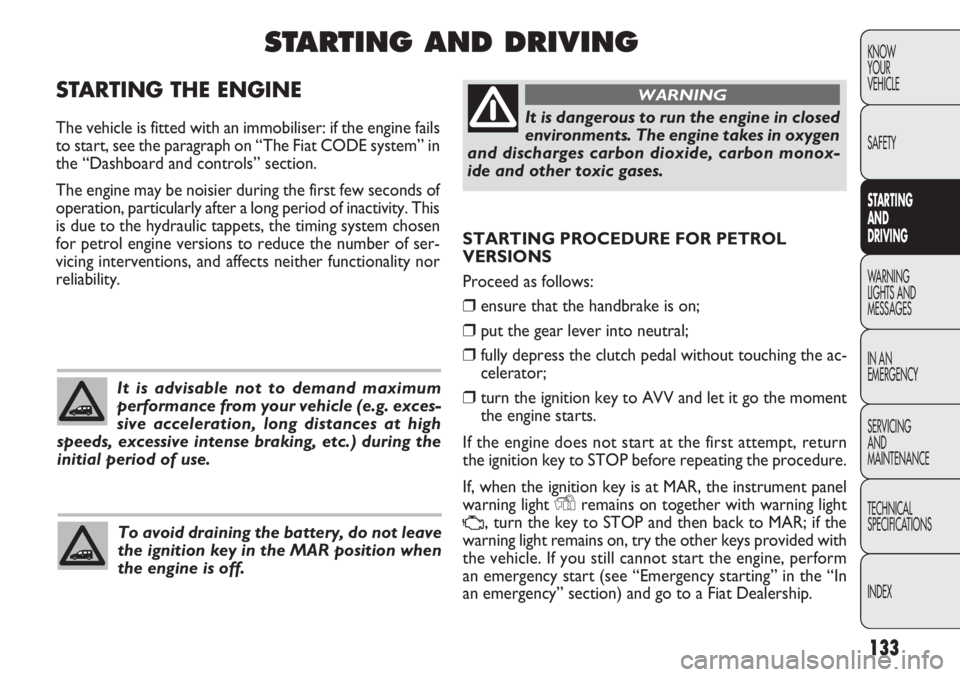
133
KNOW
YOUR
VEHICLE
SAFETY
STARTING
AN
D
DRIVING
WARNING
LIGHTS AND
MESSAGES
IN AN
EMERGENCY
SERVICING
AND
MAINTENANCE
TECHNICAL
SPECIFICA TIONS
INDEX
STARTING PROCEDURE FOR PETROL
VERSIONS
Proceed as follows:
❒ensure that the handbrake is on;
❒put the gear lever into neutral;
❒fully depress the clutch pedal without touching the ac-
celerator;
❒turn the ignition key to AVV and let it go the moment
the engine starts.
If the engine does not start at the first attempt, return
the ignition key to STOP before repeating the procedure.
If, when the ignition key is at MAR, the instrument panel
warning light
Yremains on together with warning light
U, turn the key to STOP and then back to MAR; if the
warning light remains on, try the other keys provided with
the vehicle. If you still cannot start the engine, perform
an emergency start (see “Emergency starting” in the “In
an emergency” section) and go to a Fiat Dealership.
STARTING THE ENGINE
The vehicle is fitted with an immobiliser: if the engine fails
to start, see the paragraph on “The Fiat CODE system” in
the “Dashboard and controls” section.
The engine may be noisier during the first few seconds of
operation, particularly after a long period of inactivity. This
is due to the hydraulic tappets, the timing system chosen
for petrol engine versions to reduce the number of ser-
vicing interventions, and affects neither functionality nor
reliability.
STARTING AND DRIVING
It is advisable not to demand maximum
performance from your vehicle (e.g. exces-
sive acceleration, long distances at high
speeds, excessive intense braking, etc.) during the
initial period of use.
To avoid draining the battery, do not leave
the ignition key in the MAR position when
the engine is off.
It is dangerous to run the engine in closed
environments. The engine takes in oxygen
and discharges carbon dioxide, carbon monox-
ide and other toxic gases.
WARNING
Page 138 of 283
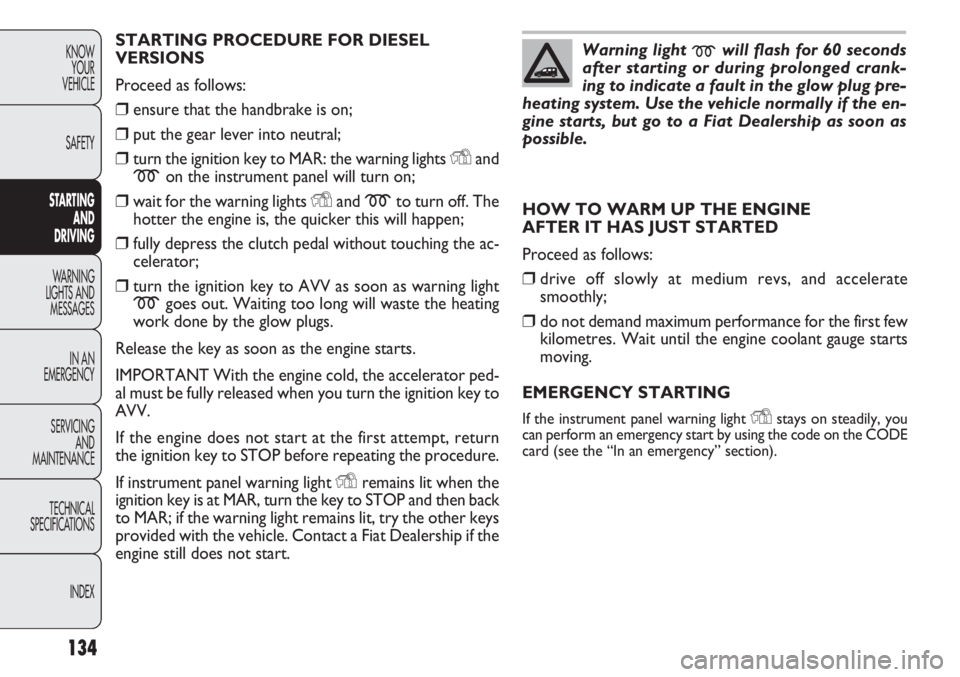
134
KNOWYOUR
VEHICLE
SAFETY
ST ARTING
AN
D
DRIVING
WARNING
LIGHTS AND MESSAGES
IN AN
EMERGENCY
SERVICING AND
MAINTENANCE
TECHNICAL
SPECIFICA TIONS
INDEX
STARTING PROCEDURE FOR DIESEL
VERSIONS
Proceed as follows:
❒ensure that the handbrake is on;
❒put the gear lever into neutral;
❒turn the ignition key to MAR: the warning lights Yand
mon the instrument panel will turn on;
❒wait for the warning lights Yand mto turn off. The
hotter the engine is, the quicker this will happen;
❒fully depress the clutch pedal without touching the ac-
celerator;
❒turn the ignition key to AVV as soon as warning light
mgoes out. Waiting too long will waste the heating
work done by the glow plugs.
Release the key as soon as the engine starts.
IMPORTANT With the engine cold, the accelerator ped-
al must be fully released when you turn the ignition key to
AVV.
If the engine does not start at the first attempt, return
the ignition key to STOP before repeating the procedure.
If instrument panel warning light
Yremains lit when the
ignition key is at MAR, turn the key to STOP and then back
to MAR; if the warning light remains lit, try the other keys
provided with the vehicle. Contact a Fiat Dealership if the
engine still does not start.
Warning light mwill flash for 60 seconds
after starting or during prolonged crank-
ing to indicate a fault in the glow plug pre-
heating system. Use the vehicle normally if the en-
gine starts, but go to a Fiat Dealership as soon as
possible.
HOW TO WARM UP THE ENGINE
AFTER IT HAS JUST STARTED
Proceed as follows:
❒drive off slowly at medium revs, and accelerate
smoothly;
❒do not demand maximum performance for the first few
kilometres. Wait until the engine coolant gauge starts
moving.
EMERGENCY STARTING
If the instrument panel warning light Ystays on steadily, you
can perform an emergency start by using the code on the CODE
card (see the “In an emergency” section).
Page 139 of 283
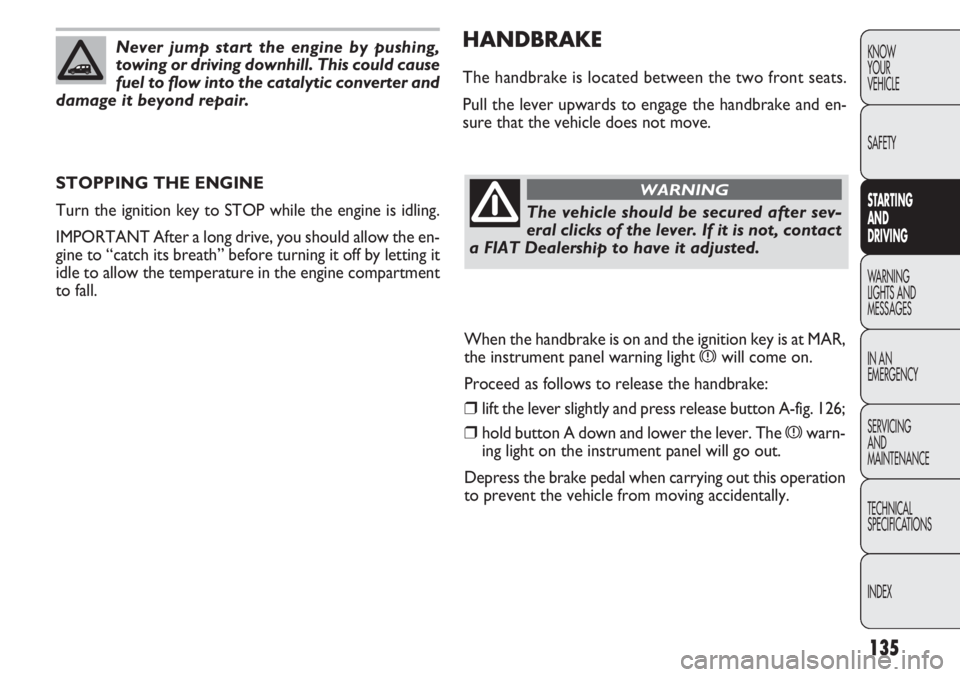
135
KNOW
YOUR
VEHICLE
SAFETY
STARTING
AN
D
DRIVING
WARNING
LIGHTS AND
MESSAGES
IN AN
EMERGENCY
SERVICING
AND
MAINTENANCE
TECHNICAL
SPECIFICA TIONS
INDEX
HANDBRAKE
The handbrake is located between the two front seats.
Pull the lever upwards to engage the handbrake and en-
sure that the vehicle does not move.
STOPPING THE ENGINE
Turn the ignition key to STOP while the engine is idling.
IMPORTANT After a long drive, you should allow the en-
gine to “catch its breath” before turning it off by letting it
idle to allow the temperature in the engine compartment
to fall.
Never jump start the engine by pushing,
towing or driving downhill. This could cause
fuel to flow into the catalytic converter and
damage it beyond repair.
The vehicle should be secured after sev-
eral clicks of the lever. If it is not, contact
a FIAT Dealership to have it adjusted.
WARNING
When the handbrake is on and the ignition key is at MAR,
the instrument panel warning light
xwill come on.
Proceed as follows to release the handbrake:
❒lift the lever slightly and press release button A-fig. 126;
❒hold button A down and lower the lever. The xwarn-
ing light on the instrument panel will go out.
Depress the brake pedal when carrying out this operation
to prevent the vehicle from moving accidentally.
Page 140 of 283
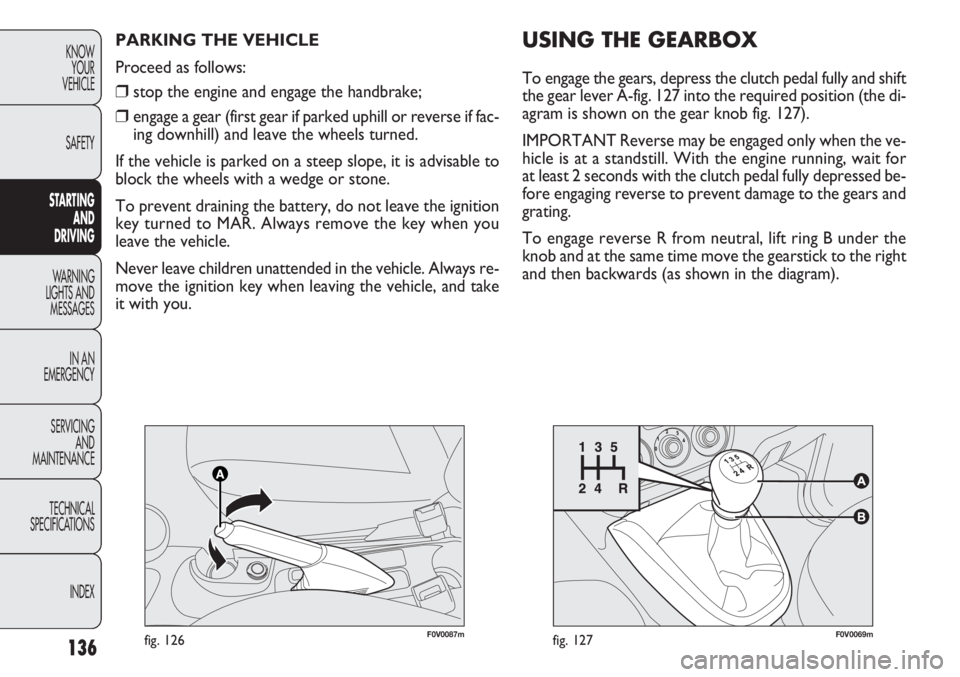
136
KNOWYOUR
VEHICLE
SAFETY
ST ARTING
AN
D
DRIVING
WARNING
LIGHTS AND MESSAGES
IN AN
EMERGENCY
SERVICING AND
MAINTENANCE
TECHNICAL
SPECIFICA TIONS
INDEX
F0V0069mfig. 127F0V0087mfig. 126
PARKING THE VEHICLE
Proceed as follows:
❒stop the engine and engage the handbrake;
❒engage a gear (first gear if parked uphill or reverse if fac-
ing downhill) and leave the wheels turned.
If the vehicle is parked on a steep slope, it is advisable to
block the wheels with a wedge or stone.
To prevent draining the battery, do not leave the ignition
key turned to MAR. Always remove the key when you
leave the vehicle.
Never leave children unattended in the vehicle. Always re-
move the ignition key when leaving the vehicle, and take
it with you.
USING THE GEARBOX
To engage the gears, depress the clutch pedal fully and shift
the gear lever A-fig. 127 into the required position (the di-
agram is shown on the gear knob fig. 127).
IMPORTANT Reverse may be engaged only when the ve-
hicle is at a standstill. With the engine running, wait for
at least 2 seconds with the clutch pedal fully depressed be-
fore engaging reverse to prevent damage to the gears and
grating.
To engage reverse R from neutral, lift ring B under the
knob and at the same time move the gearstick to the right
and then backwards (as shown in the diagram).